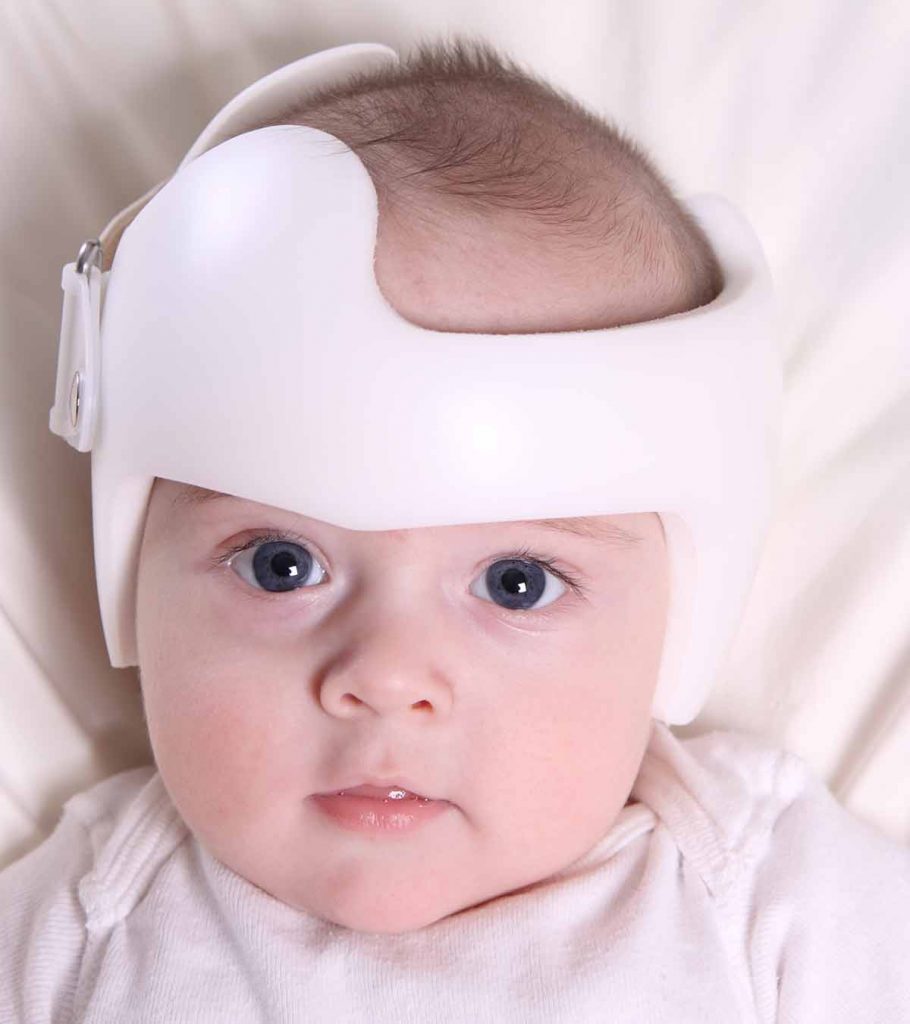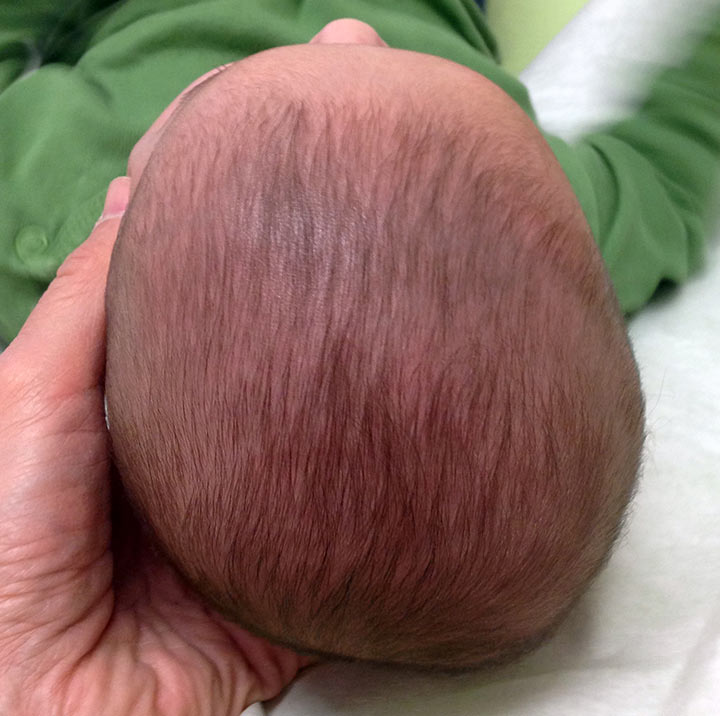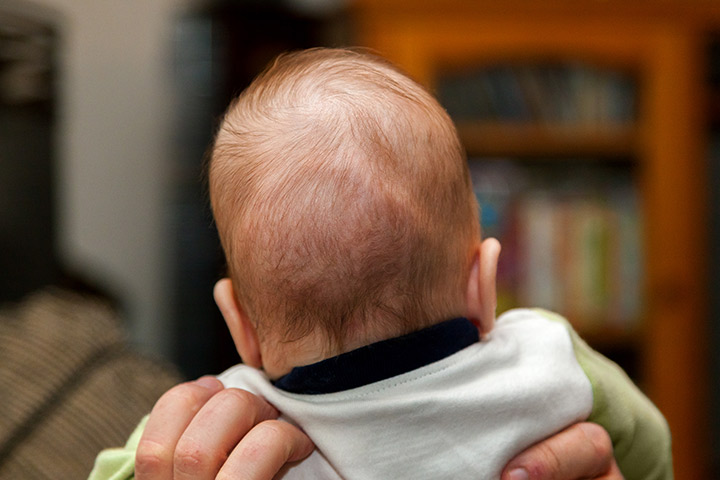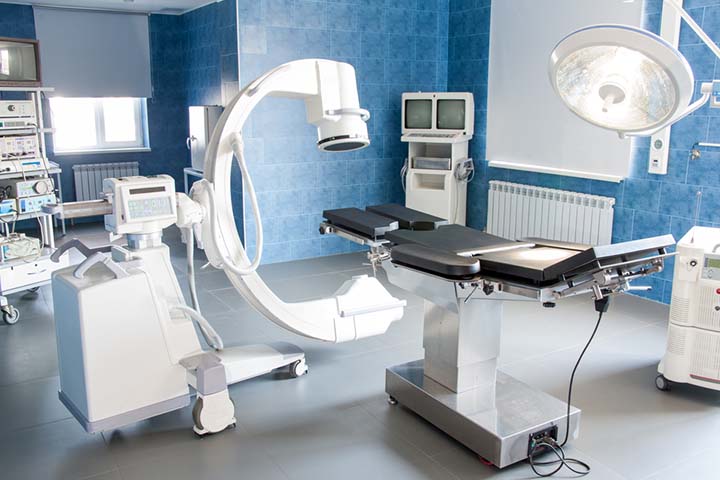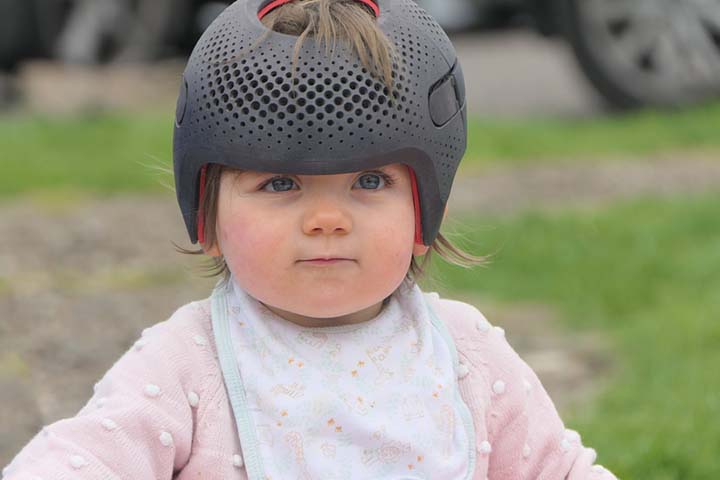Flat head syndrome in babies is characterized by an abnormal flattening of the baby’s skull, and usually, it is one sided. This condition is a cause for concern among parents as they fear it may cause permanent deformity. Keep reading this post as we tell you more about the types, causes, symptoms, diagnosis, complications, treatment, and prevention of flat head syndrome in newborns.
What Is A Flat Head Syndrome?
Flat head syndrome, also called plagiocephaly, is a developmental condition where one part of the baby’s soft skull flattens, giving an abnormal shape to the head (1). Either the back or the sides of the skull can become flat, and the location determines the type of flat head syndrome that the baby has.
Types Of Flat Head Syndrome
A flat head syndrome can be (2):
- Plagiocephaly, a term generally used for the flat head syndrome, although it refers to a head flattened only on the sides.
- Brachycephaly is when the head flattens only at the back, with the sides retaining their correct shape.
Any excess pressure on the head of the baby can cause plagiocephaly or brachycephaly. Approximately 20% to 50% of 6-month-old children are affected by deformational plagiocephaly/brachycephaly, as reported by the American Academy of Pediatrics. Learn more about the causes next.
What Causes A Flat Head Syndrome In Babies?
The following are the reasons behind a flat head syndrome in babies (3) (4) (5):
- Prolonged sleeping/lying with the head in one position: Flat head can develop in babies that spend most of their time lying on their back, with the head turned to one side. Babies should sleep only on their backs and not the sides to reduce the risk of sudden infant death syndrome (SIDS)iXSudden, unexplained death, usually during sleep, of an otherwise healthy baby less than a year old.. However, parents must alternate the position of the infant’s head to prevent the flattening of the head or deformation.
Babies who spend a lot of time in strollers and bassinets can also be at a higher risk of this Babies who spend a lot of time in strollers and bassinets can also be at a higher risk of this condition.. A flat head syndrome that arises due to a sleeping positioniXLying on the back with the face pointing upwards. is called positional plagiocephaly.
- Intrauterine complications: An abnormal fetal position can also cause pressure and change the shape of the baby’s skull or cranial bones. Other problems include low amniotic fluidiXThe clear liquid surrounding the fetus in the womb for its protection and healthy growth., which leaves the fetus vulnerable to physical shocks that deform the skull. In the case of twins or triplets, the uterus is cramped for space, and one of the babies’ head may be constantly pressed to the wall of the uterus.
- Premature birth: Preterm infants have a much softer skull compared to full-term babies. Their ability to move the neck is also limited, which causes the head to be in one position for long periods, causing that part of the head to flatten.
- Problems with neck muscles: A condition called torticollis causes the head to twist in one direction due to the contraction of neck muscles (6). It leaves the head tilted in one direction even while sleeping, which increases the risk of plagiocephaly.
- Craniosynostosis: This congenital problem leads to the fusion of one or more skull bones. A baby’s skull bones are not fused to allow expansion of the head to accommodate the rapidly expanding brain. Craniosynostosis causes a premature closure of a few bones, which forces the skull to grow into an awkward shape, sometimes leading to flat sides. However, it is not really plagiocephaly since the sutures are not closed in the flat head syndrome (7).
- Assisted delivery techniques: In case there are complications during the birth process, the doctor might suggest using assisted delivery techniques such as vacuum delivery or forceps. These methods involve using devices on the baby’s skull to aid delivery. Incorrect device use or complications during these procedures may exert pressure on the baby’s skull, causing shape distortion and increasing the chances of flat head syndrome (8).
A doctor can differentiate the two conditions.
What Are The Symptoms Of Flat Head Syndrome In Babies?
The following are the most striking features of plagiocephaly:
- One side of the head is flattened or asymmetrical while the other side looks normal.
- The skull flattens on one side at the back of the head. So the other side is normal.
- The back of the skull is completely flat while the rest of the head is in normal shape.
- The head, when seen from the top, looks like a parallelogram or has an elongated shape, but not a circle like it usually should be. It may also look oval or like a circle chipped on one side.
- You can feel the flattened bone on the sides or back of the head when you run your hand gently over the baby’s head.
The flat head syndrome does not cause pain or discomfort to the baby.
How Is The Flat Head Syndrome Diagnosed?
Here is how a pediatric doctor can tell if it is a flat head syndrome:
- Visual and physical inspection: Since the condition is easy to spot, a medical professional is most likely to diagnose plagiocephaly by visual examination alone. The doctor will also touch and feel the skull to check if there are any other problems. They may ask about the baby’s present and past sleeping positions.
- X-ray: X-rays help accurately pinpoint the flattened skull bone, and can also determine if any two bones are fused.
- CT scans: A computed tomography scan (CT scan) is seldom needed, but may be recommended if the extent of the flat head is severe. CT scan can accurately differentiate between plagiocephaly and craniosynostosis.
Treatment Of The Flat Head Syndrome
The treatment of plagiocephaly depends on the extent of the problem. A doctor will use a sequential approach to treat the condition. Treatment methods to cure a flat head syndrome in babies include:
1. Repositional therapy:
- The first step is to get the head back in its shape – start by ceasing placement of the head in the same position.
- The doctor will suggest how to place the baby’s head to rectify the misshapen skull gradually. This method is called repositional therapy.
- You need to observe a series of steps at a set frequency every day to reduce the flatness of the head.
- An alternative treatment option is recommended if repositional therapy does not help even after a year.
2. Helmet therapy:
The helmet therapy is the next best treatment option if repositional therapy doesn’t help.
- Plagiocephaly helmets are made with a hard shell on the outside and a soft foam padding inside. The helmet is custom-made for your baby’s skull and will cover the top, sides, and the back of the head.
- The walls of the helmet exert gentle yet continuous pressure on the affected side, slowly bringing the head back to its normal shape.
- The baby will have to wear a helmet for nearly 2-3 hours a day, for three to six months. This method works best if you begin treatment when the baby is 5-6 months old since it is the age when their skull is still very soft.
- An alternate version of the helmet is the headband, which is similar to the helmet, but only goes around a part of the head like a headband.
Advantages of this helmet include safety and the lack of any side effects while rectifying the misshapen skull.
The major drawback is a lack of adequate scientific evidence to prove its effectiveness in moderate and severe cases of plagiocephaly. Helmets are also expensive since they are custom-made and you can only get them from a certified craniofacial specialist.
As the baby’s head changes shape, you will need to get new helmets as and when required until the therapy is complete. Although the helmets are lightweight, some infants may find them irritating.
3. Treatment of the underlying condition:
- If your baby has torticollis, then they will have to be treated for that condition before being treated for a flat head.
- Torticollis is treatable through surgery and corrective braces. These methods, coupled with proper physiotherapy, will allow the baby to get rid of plagiocephaly slowly.
- In the case of premature babies, treatment doesn’t begin until they are old enough to endure the procedures. Talk to your doctor to figure out the best course of treatment of flat head syndrome in premature babies.
When not treated in time, this condition could give rise to certain complications sometimes.
What Are The Complications Of Flat Head Syndrome In Babies?
The condition is usually treated during infancy and toddlerhood and doesn’t carry into the childhood and beyond. An older infant can move their head and does not put pressure on one portion of the skull, eventually rectifying the shape of the head (9). But if the condition persists, the skull could become permanently deformed, which is perhaps the only complication of this condition.
You can prevent plagiocephaly by taking a few precautions.
How To Prevent Flat Head Syndrome In Babies?
A few simple precautions can prevent the flat head syndrome. Here is what you should do.
- Place the baby in the crib and alternate head positions: If the baby’s head was turned to the left during the previous nap, it should be turned to the right during the next. The same rule applies to night time sleeping. Alternate the head position every time you place the baby in the crib. Just ensure that the baby sleeps on the back, which is the best position for babies (10).
- Do not place the baby in a stroller or bassinet all the time: Do not put the baby in strollers and bassinets for longer than needed as that can make them prone to a flattened head.
- Tummy time: Give them plenty of tummy time to strengthen their muscles and also exercise their neck muscles (11). Stronger neck muscles help improve the baby’s control over their head, which can enhance the head’s range of motion.
- Let your baby sit in an upright position: You can hold the baby in your arms or place them in a sitting position while supporting their back. Staying upright in your arms is perhaps the next best thing after tummy time to prevent the onset of plagiocephaly.
- Prompt treatment of torticollis: Get your child’s torticollis treated on time so that it does not lead to a flat head.
- Mustard pillow has been found to be quite effective.
Never use pillows, mattress, or head wedgeiXA triangle-shaped pillow that raises the top half of the body during sleep. to rectify or prevent flat head syndrome. Pillows and sleep wedges increase the risk of suffocation. Babies can sleep with a pillow only after they are at least 1.5 years old (12).
In babies, flat head syndrome gives an unusual shape to their head, causing the sides or the back to flatten. Prolonged sleeping in the same position, premature birth, and intrauterine complications can result in this condition. Doctors diagnose flat head syndrome by the physical features, X-ray, or CT scan, and treatment may involve different therapies. However, the condition should not be a reason for worry as it does not impact the child’s cognitive abilities. In addition, alternating head positions and other good sleeping practices may help prevent the flat head syndrome.
Key Pointers
- Flat head syndrome flattens either the side or back of a baby’s head, resulting in an abnormal appearance.
- Prolonged sleeping in one position, intrauterine complications, premature birth, problems with neck muscles, and craniosynostosis cause flat head syndrome.
- Treatment options for the flat head syndrome are repositional therapy, physical therapy, helmet therapy, and surgery (in severe cases).
- To prevent the flat head syndrome, change the baby’s head position while sleeping, and use physical therapy to strengthen neck muscles.
This informative video discusses Plagiocephaly, a common condition in babies that causes a flat head. Discover how to prevent and treat it!
